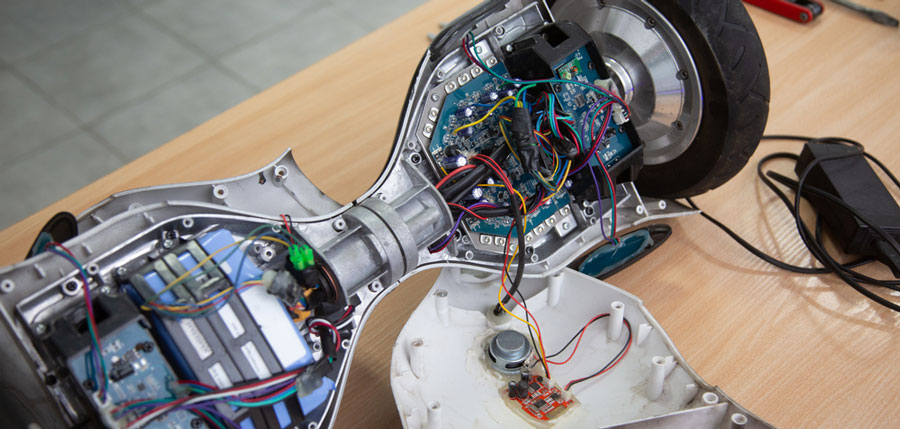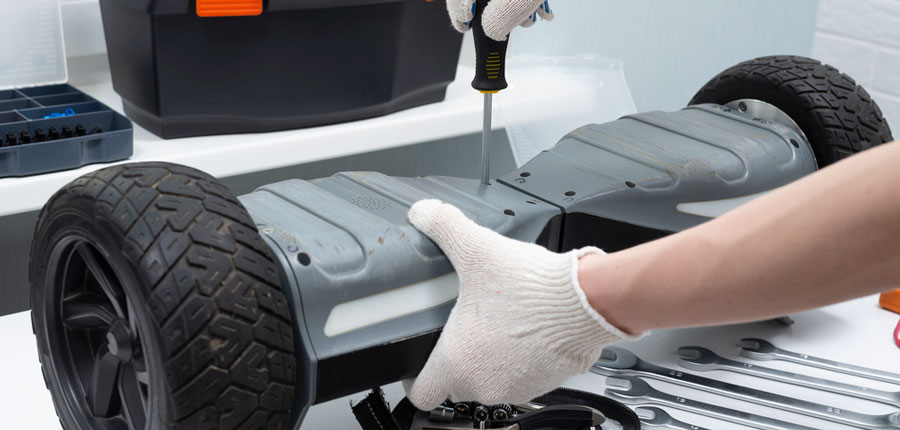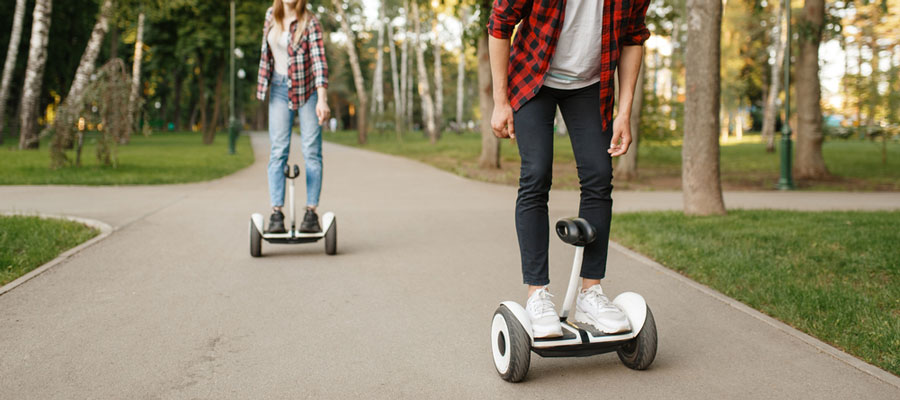A hoverboard is a self-balancing device that can be used to transport a rider with just the slightest movements of their body. The self-balancing control mechanism uses a built-in gyroscope and sensor pads to maintain the centre of gravity of the user while directing power to the motors and providing force to propel the user either forwards or backwards.
A self-balancing hoverboard is essentially a personal transportation device that uses two motorised wheels and articulated pads to control a rider’s speed and direction. They are also known as self-balancing scooters, self-balancing boards, segway, swegway, plank-wagon, e-boards, and simply as hoverboards. In less flattering terms, they have also been referred to as death boards, and a “free hospital pass”.
How does a self-balancing hoverboard work?
The name can be a little deceiving as hoverboards don’t really “hover” at all. Self-balancing hoverboards use 2 small wheels and a complex arrangement of electric motors and sensors to operate.
The self-balancing component uses a built-in gyroscope that maintains orientation and provides angular velocity for the rider. Sensors in the footpads allow the rider to steer the hoverboard, as well as provide sensors that track the centre of gravity of the rider.
If the rider leans forward, the hoverboard will propel forward, if the rider returns to the centre of gravity, the hoverboard will decrease power until it stops.
What are the different parts that make a hoverboard
Essentially, they use 2 wheels, rechargeable lithium-ion batteries, small electric motors, and a complex arrangement of sensors and a gyroscope to propel riders wherever they want to go. While hoverboards have evolved considerably over the past few years, the most modern models still feature the same components as their predecessors.
All hoverboards are made up of the following:
- 2 wheels (usually made from a hard polyurethane (PU) plastic or rubber)
- 2 motors (one controlling each wheel)
- Foot paddles and frame
- Rechargeable battery
- Gyroscope
- Electric sensors
- Electrical wiring
Each wheel is connected to a small electric motor that is positioned inside or behind the wheel hub. The motor allows for motion in both directions and will vary in power output with a motor for 8.5-inch wheels providing 400 watts.
Depending on the model and type of your hoverboard (on-road or off-road), your wheel sizes will be either 6.5-inch (16.5-cm wheels), 8.5-inch (21.5-cm wheels), or 10-inch (25.5-cm wheels).

Most modern hoverboards use rechargeable lithium-ion batteries that provide around 36 volts and approx 4400 mAh of power. This will allow for somewhere between 45 minutes and 1 hour of use and will require around 6-8 hours to fully recharge.
Hoverboards use a complex arrangement of electrical components and sensors to power and control the device. Sensors located in the footpads allow for movement by leaning slightly forwards or back, and this is translated to the motors through a series of wiring.
A hoverboard uses a gyroscope to ascertain a centre of gravity for the rider, where it can maintain balance by either supplying small amounts of power to the motors to keep it self-balanced.
If the foot sensor pads adjust forwards or back, the hoverboard uses the gyroscope to calculate how much and relay the amount of power to the motors, sending the hoverboard in the direction required.
When were they invented?
Hoverboards were first patented in February 2013 by American businessman Shane Chen. The patent and initial design were set up as a product and were initially funded on Kickstarter in May 2013.
A majority of early hoverboard models were manufactured by several companies in China with exports all over the world. Manufacturer quality varied dramatically and over the years there have been numerous product recalls and customer warnings regarding hoverboards.

Despite safety concerns, the hoverboard’s popularity exploded, mainly due to several well-timed endorsements by celebrities including Justin Bieber, Jamie Foxx, and Kendall Jenner just to name a few.
In recent years, many doctors and A;E workers have heavily criticized hoverboards and pushed for tougher safety controls. Legislators have responded in numerous states by banning the use of hoverboards on public roads, parks, and grounds.
What’s the point in these things?
So are hoverboards just another fad that’ll die out in a few years or are they here to stay? That all depends on your perspective. If you’re frontline in the A;E department, it’s likely your opinion is that hoverboards are a safety hazard and are incredibly dangerous and should be banned.
If you own a hoverboard then you know just how fun these things are. They’re also convenient for zipping around town, more environmentally friendly than a car, and give you street cred.
Hoverboards are unique as they use electrical sensors and a gyroscope that control the motors to self-balance. Other transport vehicles such as bicycles, skateboards, and rollerblades rely on the rider to balance and propel themselves.
Are they just a toy?

Hoverboards started out as a new fad gadget that was an eye-catching way to collect the newspaper or scoot around town. Nowadays, they are used for a range of recreational and commercial applications. While the appeal is obvious for kids, adults have embraced the next mode of transport too.
Hoverboards are designed in a range of models and cater to adult and child riders. Models that use smaller 6-inch wheels often have far less powerful motors and cannot reach the speeds of models intended for adult use. So, it depends on which model you buy and make sure yours is intended for adults.
Are all hoverboards self-balancing?
While various models offer better (or worse) performance based on the components used, the self-balancing component is an integral part of the riding experience for any hoverboard. Without the self-balancing feature, the hoverboard would not be able to function properly and would not work.
Can you still fall off them?
Mounting and dismounting the hoverboard cause the most issues, and result in most people falling off the hoverboard a few times whilst learning.
Are they easy to ride?
Hoverboards are a great way to get around but many find them very difficult to operate in the early stages. Much like riding a bike, they require a certain amount of training and balance for the rider which can take a little while to get used to.
Are they the same as Segways?

Segways are the big brother of hoverboards and often weigh in excess of 50 kg. Segways are typically far more robust and have a metal chassis and frame, whereas hoverboards are usually made of plastic components. Segways also use a handlebar to aid balance and steering whereas hoverboards are controlled by the footpads and sensors.
If you haven’t tried a self-balancing hoverboard go easy on your first attempt and expect to fall off a few times. As with anything new, they take some practice and with these, a lot of balance too.